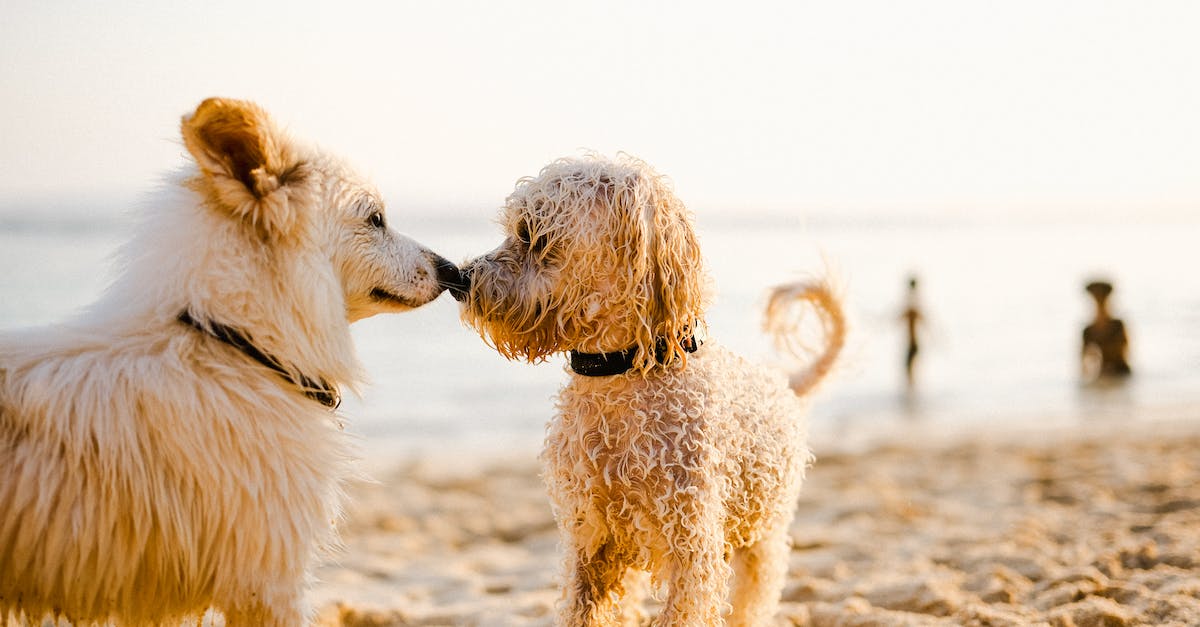Business
Mastering the Art of Introducing Dogs: Essential Tips for Successful Introductions
Learn how to introduce an adult dog to a pack of dogs with these expert tips. Find out how to choose a neutral territory, supervise interactions, and gradually increase their time together. Understand that patience is key as the introduction process can take time. Ensure a smooth transition for your furry friends.
Published
1 year agoon

Are you thinking about introducing a new furry friend into your family? The process of introducing dogs can be both exciting and nerve-wracking. As a dog lover and experienced pet owner, I understand the importance of a smooth and successful introduction. In this article, I’ll share my top tips and strategies for introducing dogs to ensure a harmonious and happy coexistence. Whether you’re introducing a new puppy to your resident dog or bringing home an adult dog to join your pack, I’ve got you covered with practical advice that will make the introduction process a breeze. So, let’s dive in and discover the secrets to a successful dog introduction!
Preparing Your Home for the New Addition
When introducing a new dog to your home, it’s important to create a comfortable and welcoming environment for both your new addition and your resident dog. By taking the time to prepare your home before the big day, you can make the transition smoother and more successful. Here are a few tips to help you get started:
1. Create separate spaces: Set up separate areas for each dog to retreat to when they need some alone time. This could be a crate, a dog bed, or even a designated room in your home. Giving each dog their own space will help prevent conflict and allow them to have some privacy.
2. Stock up on supplies: Before bringing your new dog home, make sure you have all the necessary supplies. This includes food and water bowls, toys, leashes, and ID tags. Having everything ready in advance will help you focus on introducing the dogs without any last-minute distractions.
3. Clean and remove hazards: Give your home a thorough cleaning to remove any potential hazards that could cause harm to either dog. Pick up small objects that could be chewed on, secure loose wires, and tuck away any toxic plants. Creating a safe environment is crucial for the well-being of both dogs.
4. Consider scent swapping: Dogs rely heavily on their sense of smell, so a great way to introduce them is by doing a scent swap. Before the introduction, rub a towel or piece of fabric on each dog and then swap the scented items. This will allow them to get familiar with each other’s scent before meeting face-to-face.
5. Set up gradual introductions: Rather than jumping straight into a full-blown introduction, start with short and supervised meetings between the dogs. This could be a walk together or a brief sniffing session in a neutral area. Gradually increase the time they spend together to help build positive associations.
By following these steps to prepare your home, you’ll be setting the stage for a successful introduction between your dogs. Remember to take things slow and listen to the needs of each individual dog. With patience, consistency, and a well-prepared environment, you can help them form a strong and harmonious bond.
Introducing Dogs to Each Other
Introducing dogs to each other can be an exciting and rewarding experience, but it’s important to approach it with care and patience. Whether you’re bringing a new dog into your home or introducing a resident dog to a new addition, following a few key steps can help ensure a positive and successful introduction.
Here are some tips to help you introduce dogs to each other:
- Choose a neutral territory: Selecting a neutral location for the initial meeting can help prevent territorial behavior. A park or a friend’s yard are good options. Avoid introducing them in either dog’s home territory initially.
- Keep dogs on a leash: While introducing dogs, it’s best to have them both on a leash for control and safety. This allows you to separate them if necessary and prevents any potential aggression or chasing.
- Observe body language: Pay close attention to each dog’s body language during the introduction. Look for signs of fear, aggression, or stress, such as raised hackles, stiff posture, growling, or snapping. If you notice any of these signs, separate the dogs and try again later or seek the help of a professional trainer.
- Allow sniffing and interaction: Once both dogs are comfortable and relaxed, you can allow them to briefly sniff each other and have brief interactions. Watch their behavior closely and be ready to intervene if necessary.
- Supervise each interaction: Supervise all interactions between the dogs, particularly during the initial stages. This will ensure the safety of both dogs and allow you to intervene if any issues arise.
- Gradually increase time together: As you see positive interactions and both dogs are comfortable, you can gradually increase the time they spend together. This can include supervised play sessions and walks.
Remember to reward them for positive behavior during the introduction process. Offering treats, praise, and affection can help reinforce good behavior and create positive associations between the dogs.
It’s also important to manage the dogs’ environment during the introduction process. This means keeping valuable objects hidden, eliminating potential hazards, and creating separate spaces for each dog. Proper preparation and management can help reduce the chances of conflicts and ensure a smooth transition.
By following these tips and taking the time to properly introduce dogs to each other, you can increase the chances of a successful and harmonious coexistence. Remember to be patient and allow the dogs to adjust at their own pace.
Introducing a New Puppy to Your Resident Dog
When it comes to introducing a new puppy to your resident dog, there are a few key steps that can help set the stage for a successful introduction. Here are some tips that have worked for me:
- Choose a Controlled Environment: It’s important to choose a neutral territory for the initial meeting. This can help prevent territorial behaviors from either dog and ensure a more balanced interaction. It could be a park or a friend’s backyard.
- Keep Both Dogs on a Leash: Keeping both dogs on a leash during the introduction is essential for control and safety. This allows you to guide their interactions and intervene if necessary. It’s a good idea to use a secure leash and ensure that both dogs are comfortable with being on a leash.
- Observe Body Language: Pay close attention to the body language of both dogs during the introduction. Look for signs of fear, aggression, or anxiety. These can include stiff body posture, growling, snarling, raised hackles, or excessive barking. If you notice any negative behaviors, it’s important to take a step back and reassess the situation.
- Allow Sniffing and Interaction: Giving the dogs an opportunity to sniff and interact with each other is a crucial part of the introduction process. This can be done by allowing them to approach each other at their own pace while closely monitoring their behavior. Sniffing is a natural way for dogs to gather information about each other and establish a rapport.
- Supervise All Interactions: It is important to supervise all interactions between the new puppy and resident dog. Even if things seem to be going well, it’s always better to err on the side of caution. This means being present and attentive during their time together, and intervening if any signs of aggression or tension arise.
- Gradually Increase Time Together: As the dogs become more comfortable with each other, gradually increase their time together. Start with short, supervised sessions and gradually extend the duration. This allows them to build trust and familiarity without feeling overwhelmed.
By following these steps and being patient, you can increase the chances of a successful introduction between your new puppy and resident dog. Remember, each dog is unique, and the introduction process may take time.
Introducing an Adult Dog to Your Pack
Introducing an adult dog to your pack can be a delicate process that requires patience and careful management. Whether you’re adding a new dog to your existing group or introducing a rescue dog to your current canine companion, it’s important to approach the situation with caution.
Here are some tips to help you introduce an adult dog to your pack and ensure a smooth transition:
- Choose a neutral territory: To avoid territorial disputes, it’s best to introduce the dogs in a neutral location, such as a park or a neighbor’s yard. This can help reduce tension and prevent any one dog from feeling threatened.
- Keep both dogs on a leash: Leashes provide control and ensure the safety of both dogs during the initial meeting. It also helps you intervene if any aggressive behavior occurs. Keep the leashes loose to allow for natural interaction and sniffing.
- Observe their body language: Dogs communicate through their body language. Pay close attention to their posture, tail position, and facial expressions. If either dog shows signs of fear, aggression, or discomfort, it’s important to intervene and separate them.
- Allow sniffing and interaction: Sniffing is a natural way for dogs to gather information about one another. Allow them to sniff each other, keeping a close eye on their reactions. If they seem comfortable, you can gradually allow them more freedom to interact.
- Supervise all interactions: Always supervise the dogs’ interactions, especially in the initial stages. Be prepared to step in and redirect their behavior if necessary. Your presence and guidance can help establish a positive dynamic between the dogs.
- Gradually increase their time together: Start with short, supervised visits and gradually increase the duration of their time together. This allows the dogs to become more familiar with each other and helps build positive associations.
Remember, introducing adult dogs to each other can take time and should be done at a pace that is comfortable for both dogs. Don’t rush the process and be prepared to adjust your approach based on their behavior and comfort levels.
By following these tips, you can foster a positive relationship between your new dog and existing pack members. With patience and proper introductions, you can create a harmonious and well-adjusted canine family.
Conclusion
Introducing dogs to each other can be a delicate process, but with the right approach, it can be a successful and rewarding experience. By following the tips outlined in this article, you can ensure a smooth introduction and foster positive relationships among your furry friends.
Choosing a neutral territory for the initial meeting allows both dogs to feel comfortable and reduces the chances of territorial behavior. Keeping both dogs on a leash provides control and ensures their safety. Observing their body language is crucial in understanding their reactions and emotions.
Allowing sniffing and interaction between the dogs allows them to establish a bond and build trust. Supervising all interactions is essential to prevent any potential conflicts or aggression. Gradually increasing their time together helps them acclimate to each other’s presence.
Remember, patience is key during the introduction process. Every dog is unique, and it may take time for them to adjust and form a bond. By following these guidelines, you can create a harmonious pack and provide a loving and supportive environment for your furry companions.
How do I introduce an adult dog to a pack of dogs?
Introducing an adult dog to a pack of dogs should be done in a neutral territory. Keep both dogs on a leash for control and safety. Observe their body language and allow sniffing and interaction. Supervise all interactions and gradually increase their time together. Patience is key as the introduction process may take time.
What is the importance of introducing dogs in a neutral territory?
Introducing dogs in a neutral territory reduces territorial aggression and allows them to interact without feeling intruded upon. This helps create a more relaxed and positive environment for the introduction.
Why should both dogs be kept on a leash during the introduction?
Keeping both dogs on a leash ensures control and safety during the introduction process. It allows you to step in if necessary and prevents any potential fights or other unwanted behaviors.
What should I look for in their body language during the introduction?
Observe their body language for signs of comfort, stress, or aggression. Look for relaxed postures, loose body movements, wagging tails, and friendly/playful behavior. Avoid any signs of tension, stiffness, growling, or raised hackles.
Should I allow sniffing and interaction between the dogs?
Yes, allowing sniffing and interaction is an important part of the introduction process. It helps dogs exchange scents, establish a level of familiarity, and gradually build a positive rapport with each other.
Why is it important to supervise all interactions between the dogs?
Supervising all interactions ensures the safety of the dogs involved. It allows you to intervene if needed, redirect their behavior, or separate them if tensions arise. Supervision also helps prevent any aggressive or dominant behaviors from escalating.
How long does the introduction process usually take?
The introduction process may vary in duration depending on the individual dogs involved. It could take several short sessions or weeks of gradual exposure for the dogs to become comfortable with each other. Remember to be patient and let them progress at their own pace.
With over a decade of experience in the tech industry, Priya Sharma is a seasoned software engineer and tech blogger. She holds a Bachelor's degree in Computer Science from the Indian Institute of Technology (IIT) and has been a key contributor to cutting-edge projects in artificial intelligence and software development.

You may like
Mobility Scooter


Sideways Market: Navigating the Fluctuating Trends
Understanding Market Volatility Market volatility refers to the degree of variability in the price of a financial instrument within a...


Enhance Your iPhone with Adorable Cute Wallpapers
Looking to jazz up your iPhone screen with some cuteness? Discover the impact of adorable wallpapers on your device's look...


Glow Berry Prime: The Science Behind its Skincare Revival
Discover the transformative power of Glow Berry Prime in skincare with its potent blend of 20% Vitamin C, 2% Hyaluronic...


Glov Beauty: Eco-Friendly Products Review | Glov Beauty Reviews
Discover Glov Beauty's eco-friendly products like the Glov On-The-Go set with 500+ uses and the gentle exfoliation offered by the...


Unlocking Drake’s FPS Lyrics: How Gaming Influences His Music
Discover how Drake's lyrics in the first-person shooter-inspired track "War" reflect the influence of FPS games on his music. With...


Defeating a Fire-Breathing Dragon: Strategies for Mage Survival
Prepare yourself for an intense battle as we explore how to face a dragon capable of reaching temperatures over 2000°F....


Exploring Student Life at Glitties Eckerd College
Discover the dynamic student experience at Glitties Eckerd College with a plethora of club options, competitive sports, and community service...


Discover Success Stories with Money6x Real Estate Strategy
Discover the lucrative world of real estate investing with Money6x strategy! Uncover real-life success stories of investors achieving impressive 8-12%...


Get an Inside Look at Julion Alvarez’s 2024 USA Tour
Discover the meticulous planning behind Julion Alvarez's 2024 USA tour! Dive into the world of setlist curation, choreography design, and...


Enhancing Connections through Diversity & Active Listening
Learn how treating peers with empathy and actively listening can enhance relationships and boost innovation. The article emphasizes the significance...